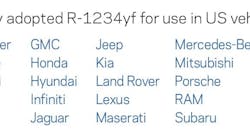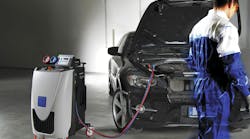The Timken Company announced Sept. 5 that its board of directors has approved a plan to pursue a separation of the company’s steel business from its bearings and power transmission business through a spinoff, creating two publicly traded companies.
“Timken has a long and successful history of creating value for its shareholders,” said James W. Griffith, president and chief executive officer. “Over the past several years, we have transformed the business and delivered superior financial performance by diversifying and expanding customer markets and product lines, making strategic, accretive acquisitions, and introducing new capabilities around the world. We see this initiative – to build out two strong, focused companies – as further evidence of our commitment to drive value for our shareholders and our customers.”
Griffith noted that the two stand-alone companies will continue to advance their distinct growth strategies within their respective core markets, which is expected to further improve competitiveness. “The bearings and steel businesses are well-run and well-positioned in their markets to perform well through economic cycles and have successfully implemented the Timken business model,” Griffith added. “We have talented, capable and dedicated employees who we believe will drive these businesses to new levels of success as separate entities.”
Strategy Committee Evaluation
The board’s decision to split Timken into two companies resulted from a thorough evaluation by a strategy committee composed of independent directors and established by the board in response to shareholder input. With the help of financial and strategic advisors, the strategy committee carefully evaluated the financial and operational implications of separating the company’s businesses, along with potential changes to the company’s corporate governance and capital allocation strategy.
Joseph W. Ralston, the board's lead independent director, said, "The strategy committee and board concluded that even with the company's success in improving performance in recent years and an impressive track record of accomplishments, the company's share price has not appropriately reflected our significant progress. With our shares trading at a discount to our peers, we recognized the need to examine opportunities to better drive value in the market.
“Through the course of our work, it became clear that creating two focused companies would allow investors to more fully appreciate and value the unique strategic and financial strengths of each business, including operating performance, margins, earnings and cash flow,” Ralston added.
“The process that the strategy committee completed convinced us of the value-creation opportunities that can come from separating the company’s businesses,” said Ward J. “Tim” Timken, Jr., board chairman. “Today’s decision is the appropriate ‘next step’ to build on the momentum created by our improvement in the performance and underlying fundamentals of each of our core businesses. These are two winning businesses and we are confident that both can sustain the market-leading performance they have achieved over the past few years.”
The board recognizes the benefits shared between the businesses and will work to maintain them through a mutually beneficial business relationship between the two independent companies. Company leaders will also work to minimize the impact of incremental stand-alone costs that will be incurred as a result of the separation as well as leverage the opportunities that come from operating as two focused companies.
The New Stand-Alone Engineered Steel Company
The new publicly traded engineered steel company would have estimated annual revenue of $1.7 billion and is expected to have strong prospects for growth and margin improvement. Over the past decade, the engineered steel business has implemented changes that increased margins, dramatically lowered its breakeven point and streamlined its supply chain. Headquartered in Canton, Ohio, the engineered steel company will include approximately 3,000 associates, seven manufacturing plants, four warehouses and five sales offices. The steel business is North America’s leading manufacturer of SBQ large bars for industrial markets and its largest producer of seamless mechanical tubing.
The engineered steel company will continue to drive value through a business model that provides differentiated solutions to meet customer demands in industries where performance matters. The premium steelmaker manufactures carbon, micro-alloy and alloy steels with annual melt capacity of more than 1.8 million tons. Recent investments are expected to significantly strengthen the engineered steel company’s position as a leader in providing differentiated solutions for the energy, industrial and automotive markets, and enhance its operational performance.
The Timken Company
Post separation, The Timken Company would have estimated annual revenue of $3.4 billion consisting of the Process Industries, Aerospace and Mobile Industries segments. The company will continue to focus on numerous fast-growing attractive markets, supported by both organic expansion and acquisitions. The business leverages its technology and engineering capabilities to offer more reliable customer solutions and enhanced products and services with particular emphasis in emerging markets where infrastructure is fueling geographic growth. Its focus on applying its know-how and providing superior customer service differentiates the business in the areas of product performance, on-time delivery and service support.
The Timken Company’s product portfolio includes a broad range of bearings and related mechanical power transmission components and services. Employing nearly 17,000 associates, the company will have 35 manufacturing plants, 25 service and repair facilities, four technology centers, and an extensive network of sales offices and warehouses around the globe. Company headquarters will remain in Stark County.
Experienced Executives to Lead Both Companies
Griffith, 59, will continue as president and chief executive officer of The Timken Company until the separation is complete, at which time he plans to retire after 30 years of service. The board plans to name Richard G. Kyle, 47, as The Timken Company’s new president and chief executive officer, succeeding Griffith. Until then, Kyle has been named chief operating officer of the B&PT business. Kyle joined the company in 2006 with extensive industry experience and has held executive positions at Timken that include vice president of manufacturing, president of Aerospace and Mobile Industries, and, most recently, group president.
The board also plans to name Ward J. “Tim” Timken, Jr., 46, to lead the new engineered steel company as its chairman and chief executive officer. Timken’s career at the company began in 1992 in the steel business as senior steel business analyst. In 2004, he was named president of the steel business, and he was elected chairman of the board in 2005. Timken will continue to serve as chairman as well as oversee the steel business until the separation.
“We have had sound succession plans in place for some time,” said Ralston in making the leadership announcements. “Rich Kyle and Tim Timken have substantial experience and are well- equipped to lead these two companies. The board unanimously supports them, and I am confident they will continue building momentum to maximize value for the employees, investors and customers of both companies.”
Following the separation, the board plans to name John M. Timken, Jr., 62, non-executive chairman of The Timken Company. In that role, he assumes leadership responsibility for board activities and will oversee related board matters. Timken has been an active member of The Timken Company’s board since 1986.
“John Timken has been involved in some of the biggest changes in The Timken Company’s history, including acquisitions, divestures and major expansions,” said Ralston. “His deep understanding of the company will be invaluable to the next group of Timken Company directors.”
Planned Capital Structure and Governance Actions
In addition to its strategic evaluation, the board also has completed a review of The Timken Company’s capital allocation process and objectives and corporate governance. With respect to capital allocation, the company will continue to target net debt-to-capital in the range of 30 to 35 percent, emphasizing a combination of capital return initiatives in the form of share repurchases and dividends as well as strategic investments for the business including capital expenditures and acquisitions.
The company currently has in place an active share buyback program and has already purchased 1.8 million shares this year. Currently, 5.7 million shares remain under the existing board- authorized 10 million share buy-back program. “We expect to remain active in seeking opportunities to repurchase shares and will utilize our balance sheet accordingly,” Griffith noted.
Timken has a track record of paying dividends for 365 successive quarters since it became a publicly traded company in 1922 and will continue to evaluate its dividend at regular quarterly intervals.
The company has actively funded its pension plans, which it expects to be substantially fully funded by the end of the year. The company does not anticipate making further discretionary contributions.
Timken will complete its current capital investment program for both businesses, which includes a new continuous caster for the steel business to come on-line in the second half of 2014, and expects investment levels to return to more normal levels thereafter.
“Plans call for both companies to be capitalized in a manner that provides the financial flexibility needed to pursue future growth opportunities,” Griffith said. At separation, both companies are expected to have strong balance sheets and their respective pension plans substantially fully funded.
Regarding corporate governance, the board noted that following the 2013 Annual Meeting of Shareholders, John M. Timken, Jr., withdrew his name from consideration for the audit committee. The board also announced that Ward J. Timken, 71, expects to retire from the board in May 2014 at the end of his current term, in accordance with the director retirement policy.
At a later date, The Timken Company and the new stand-alone engineered steel company will name new separate boards of directors, which are expected to include a strong base of directors drawn from The Timken Company’s current board membership along with new board members.
Subscribe to Aftermarket Business World and receive articles like this every month….absolutely free. Click here.


